An anonymous contemporary of Geoffrey Chaucer wrote Sir Gawain and the Green Knight in the 14th century. It was written in a Northern dialect and uses alliteration similar to the Anglo-Saxon form of poetry. Alliteration is characterized by the repetition of consonants and a sharp rhyme at the end of each section.
The story begins as King Arthur's court celebrates the New Year for fifteen days. The lords and ladies of the court are having a great time dancing and feasting. The story describes the lavishly served feast with all the trimmings. Each guest is free to partake in the royal meal. However, King Arthur will not eat on such a high holiday until someone tells a fascinating or adventurous tale.
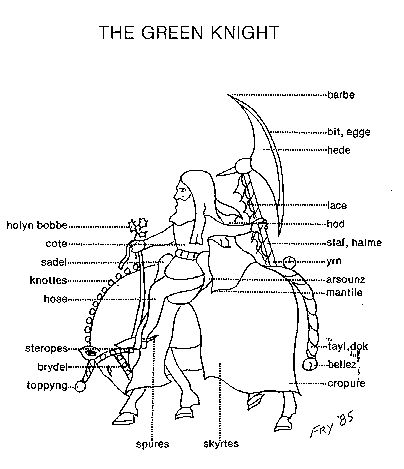 entirely green. He is, of course, the Green Knight. Even his clothing is described in detail as entirely green. In one hand he holds a large ax and in the other he holds a holly bob. The Green Knight asks to see the leader of the crowd.
entirely green. He is, of course, the Green Knight. Even his clothing is described in detail as entirely green. In one hand he holds a large ax and in the other he holds a holly bob. The Green Knight asks to see the leader of the crowd.King Arthur stands up and speaks to the Green Knight, obviously excited by the thought of the tales that this stranger will tell. The Knight offers a challenge to anyone brave enough to accept it. The Green Knight will allow his opponent to strike his neck with the large ax that he holds. The opponent must travel to the Green Knight's castle in one year to accept a similar blow in return. When none of the knights volunteer, Arthur rises to accept the Green Knight's challenge. Sir Gawain, the youngest of King Arthur's knights, asks to be allowed to stand in for his king.
The Green Knight doesn't move or flinch as he offers his bare neck to Gawain. Gawain grabs the Green Knight's ax firmly and chops off his head. The head falls to the ground and rolls past the feet of many of the people in the court. To the shock of everyone, the Green Knight gets up, grabs the head by the hair, and mounts his horse. As he rides out of King Arthur's court, he warns Gawain to remember the agreement to meet in one year at the castle of the Green Knight.
After a year has passed, Sir Gawain must prepare to leave for his journey to the castle of the Green Knight. The other knights are sad to see such a good friend and stellar knight meet with
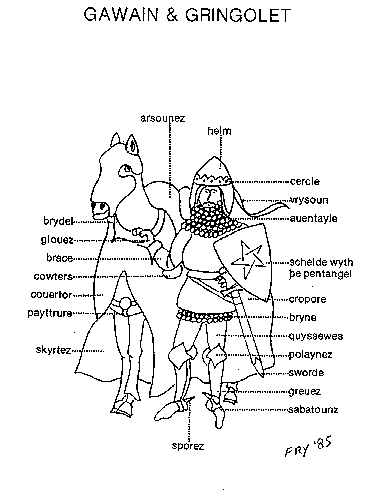 such a bitter blow. Gawain's answer to the concerns of his fellow knights demonstrates his bravery:
such a bitter blow. Gawain's answer to the concerns of his fellow knights demonstrates his bravery: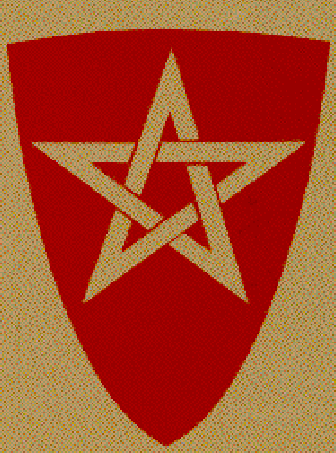 The poem describes Gawain's armor in detail. He carries a red shield that has a pentangle painted on its front. The pentangle is a token of truth. Each of the five points are linked and locked with the next, forming what is called the endless knot. The pentangle is a symbol that Gawain is faultless in his five senses, never found to fail in his five fingers, faithful to the five wounds that Christ received on the cross, strengthened by the five joys that the Virgin Mary had in Jesus (The Annunciation, Nativity, Resurrection, Ascension, and Assumption), and possesses brotherly love, pure mind and manners, and compassion most precious. The inside of the shield is adorned with an image of the Virgin Mary to make sure that Gawain never loses heart.
The poem describes Gawain's armor in detail. He carries a red shield that has a pentangle painted on its front. The pentangle is a token of truth. Each of the five points are linked and locked with the next, forming what is called the endless knot. The pentangle is a symbol that Gawain is faultless in his five senses, never found to fail in his five fingers, faithful to the five wounds that Christ received on the cross, strengthened by the five joys that the Virgin Mary had in Jesus (The Annunciation, Nativity, Resurrection, Ascension, and Assumption), and possesses brotherly love, pure mind and manners, and compassion most precious. The inside of the shield is adorned with an image of the Virgin Mary to make sure that Gawain never loses heart.Sir Gawain, on his horse Gringolet, sets off on his journey to the castle of the Green Knight. He
 must travel through the cold of the winter and fight with many fierce creatures. He rides across the country until Christmas Eve. Gawain prays with all his might that the Virgin Mary would guide him. As soon as he crosses himself three times, a castle appears. It is described as a wonderous dwelling with a moat and many trees. The grounds are described as fair and green, in a park with a palisade of plantings. It is interesting to note that up until the day before, Gawain is traveling through the icy cold of winter.
must travel through the cold of the winter and fight with many fierce creatures. He rides across the country until Christmas Eve. Gawain prays with all his might that the Virgin Mary would guide him. As soon as he crosses himself three times, a castle appears. It is described as a wonderous dwelling with a moat and many trees. The grounds are described as fair and green, in a park with a palisade of plantings. It is interesting to note that up until the day before, Gawain is traveling through the icy cold of winter.After three days of celebration, Gawain wishes to leave the castle and find the Green Knight. Bercilak tells Gawain that he knows were the castle of the Green Knight is located. Gawain agrees to stay at Bercilak's castle until it is time for him to meet the Green Knight. Bercilak asks Gawain to partake in a type of contest. The two agree that the host will go hunting in the morning and return in the evening to give all that he has caught to Gawain. In return, Gawain must give all that he has caught to Bercilak.
Bercilak leaves for the hunt in the morning. The poem gives a detailed description of the hunt for
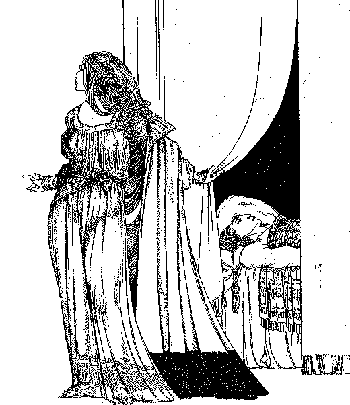 deer and its slaughter. Meanwhile, Gawain sleeps comfortably in his bed at the castle. He is awakened by the young wife of the host. She attempts to seduce the chivalrous knight. Gawain is able to refuse the advances of the woman without offending her. The two exchange only a kiss and a compliment to each other. When Bercilak returns with many deer, he offers them to Gawain. In return, Gawain bestows a kiss on the host. Bercilak and Gawain agree to repeat their agreement for a second day.
deer and its slaughter. Meanwhile, Gawain sleeps comfortably in his bed at the castle. He is awakened by the young wife of the host. She attempts to seduce the chivalrous knight. Gawain is able to refuse the advances of the woman without offending her. The two exchange only a kiss and a compliment to each other. When Bercilak returns with many deer, he offers them to Gawain. In return, Gawain bestows a kiss on the host. Bercilak and Gawain agree to repeat their agreement for a second day.The third day's hunt is for the sly fox. This time, the young wife of the host practically throws herself at Gawain. She is using all of her charms to seduce Gawain. Gawain is steadfast in his ability to reject the advances of the woman. She convinces him to accept a token to remember her by. She gives him a green garter that she tells him will protect him from any harm. Gawain will soon have to meet the Green Knight and decides that he could use some protection. He conceals the garter from the host when they exchange their prizes.
When Gawain meets with the Green Knight, he offers his neck as the Green Knight had done a year ago. The Green Knight lifts his ax and brings it down towards Gawain's neck. However, Gawain flinches and the Green Knight misses. The Green Knight taunts Gawain for flinching, since he didn't move a muscle when Gawain chopped off his head. The second time that the Green Knight brings down his ax, Gawain does not move a muscle. However, the ax misses his neck and does not harm him. The third blow from the Green Knight's ax merely nicks Gawains's neck. Gawain angrily rises and tells the Green Knight that he has had his chance, and that the game is over.
It is here in the poem that Gawain learns that Bercilak is the Green Knight. He also learns the
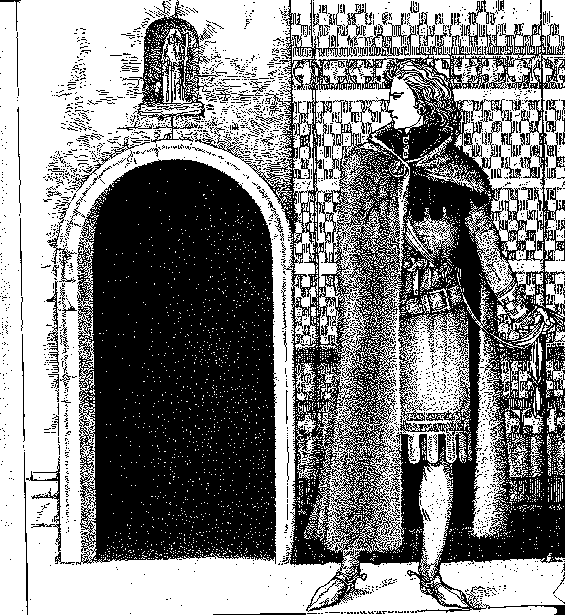 reason for the three ax blows. The first blow is for meeting the terms of their agreement, the second blow is for kissing Bercilak's wife, the third blow is for Gawain's one failure in accepting the girdle. Gawain is ashamed for his acceptance of the girdle. The Green Knight forgives Gawain for his one departure from perfect chivalry and knighthood. Gawain returns to King Arthur's court wearing the green girdle as a symbol of his cowardice. The knights of King Arthur's court all pledged to wear green garters, forming the Order of the Garter.
reason for the three ax blows. The first blow is for meeting the terms of their agreement, the second blow is for kissing Bercilak's wife, the third blow is for Gawain's one failure in accepting the girdle. Gawain is ashamed for his acceptance of the girdle. The Green Knight forgives Gawain for his one departure from perfect chivalry and knighthood. Gawain returns to King Arthur's court wearing the green girdle as a symbol of his cowardice. The knights of King Arthur's court all pledged to wear green garters, forming the Order of the Garter.Despite his acceptance of the garter, Gawain lives up to his reputation as the most chivalrous of the knights in King Arthur's court.
No comments:
Post a Comment